#Al Sarraj
Text
Secondo alcune fonti , le forze pro-Haftar si stanno accumulando a sud di Tripoli, e anche le forze pro-GNU si stanno accumulando.
Di fatto, il carico di armi dato da Haftar alla causa Ucraina (transitato sopra i cieli europei evitando lo spazio aereo Italiano) come richiesto da UE e NATO ha come contropartita Tripoli, ovvero la testa di Al Sarraj cui l'Italia si era legata. L'Italia in Libia sarà ancora più marginalizzata a favore di Turchia e arabi. E l'appecorato gruppo di potere italiano, cui Meloni e i suoi rappresentano la formale espressione politica, seguirà a sostenere chi ci sta tagliando le gambe e un accesso a fonti energetiche vitale per l'economia. Tutto questo al grido di "Slava Ukraijna".
5 notes
·
View notes
Text

More on the murder of journalist Rushdi Sarraj in an Israeli air strike
#free gaza#gaza strip#irish solidarity with palestine#free palestine#palestine#gaza#news on gaza#al jazeera#boycott israel#israel#amnesty international#Agnes Callamard#Rushdi Sarraj
14 notes
·
View notes
Text
"bank of targets": cinema palestina al detour (roma, san lorenzo) - da oggi, 16 aprile
cliccare per ingrandire
Bank of Targets, terra di obiettivi, sponda di macerie, rovina della memoria e polvere mediatica a coprire.
Il popolo palestinese non ha mai smesso di raccontare la sofferenza sotto l’occupazione israeliana, in ogni forma possibile. L’autodeterminazione parte dal narrarsi in prima persona, senza filtri occidentali, come atto di resistenza culturale alla colonizzazione…

View On WordPress
#Bank of Targets#cinema#Circolo di San Lorenzo#Circolo San Lorenzo#Cristina Tuteri#detour#Emad Burnat#film#Gaza#genocidio#Guy Davidi#Maya Issa#Mohammed Alatar#Monica Maurer#Nour Al Ghussein#Palestina#Palestine#proiezioni#Rushdi Sarraj#San Lorenzo#Valeria Belli#video#West Bank#Yaser Murtaja
0 notes
Text
“I first started noticing the journalists dying on Instagram. I'm a journalist, I'm Arab, and I've reported on war. A big part of my community is other Arab journalists who do the same thing.
And when someone dies, news travels fast. Recently, I pulled up the list that the Committee to Protect Journalists has been keeping and looked at it for the first time. There are 95 journalists and media workers on it as of today.
Almost everyone on it is Palestinian. Scrolling through, I started to get angry. These were the people carrying the burden of documenting this whole war.
Israel is not allowing foreign journalists into Gaza, except on rare occasions with military escorts. These people's names are being buried in a giant list that keeps growing. What I want to do is lift some of them off the list for a moment and give you a glimpse of who they were and the work they made.
I'll start with Sadi Mansour. Sadi was the director of Al-Quds News Network, and he posted a 22-second video on November 18. That was a report from the war, but it also gave me a picture into his marriage.
Sadi's wearing his press vest and looks exhausted. He's explaining that cell service and the Internet keep getting cut off, and it's often impossible to text or call anyone, including his wife. So they've resorted to using handwritten letters to communicate while he's out reporting, sending them back and forth with neighbors or colleagues.
He ends the video with a picture of one of these letters from his wife. In it, she writes,
‘Me and the kids stayed up waiting for you until the morning, and you didn't come home. We were really sad.
I kept telling the kids, Look, he's coming. But you didn't show up. May God forgive you.
Come home tomorrow and eat with us. Do you want me to make you kebab or maybe kapse? Bring your friends with you, it's okay.
And give Azeez the battery to charge. What do you think about me sending you handwritten letters with messenger pigeons from now on? Ha ha ha.
I'm just kidding. I want to curse at you, but we're living in a war. Too bad.
Okay, I love you. Bye.’
A few hours after he shared that letter, Sadie and his co-worker Hassouna Saleem were at Sadie's home, when they were killed by an Israeli air strike that hit his house.
His wife and kids, who weren't there, survived.
Gaza is tiny, and the journalist community is really close. Reading the list, you can see all the connections between people. Like with Brahim Lafi.
Brahim was a photojournalist, one of the first journalists to die. He was killed while reporting on October 7. He was just 21, still new to journalism.
On his Instagram, you can see that in his posts just a few years ago, he was still practicing his photography, taking pictures of coffee cups and flowers. Then he started doing beautiful portraits and action shots. You can really feel him starting to become a journalist.
Clicking around on Instagram, I found a tribute post about Brahim from his co-worker Rushdie Sarraj. In this photo, Brahim staring intently at the back of a camera, his face lit up by the light from the viewfinder. He looks so young.
The caption reads, My assistant is gone. Brahim is gone. Rushdie himself was a beloved journalist and filmmaker.
And I know that because he's also on the list. He was killed just two weeks after Brahim. I read the tribute post to him too.
I saw this over and over again. Journalists posting tributes, who were then killed themselves soon after. And a tribute goes up for them.
And then the pattern continues.
Thank you.
Something else I saw over and over on the list, journalists later in the war who had become aware that they could be making their last reports. They'd say it at the beginning of their videos. And those were the hardest to watch, especially when it was true.
One video like that was posted by Ayat Hadduro. Ayat was a freelance journalist and video blogger. Her videos before the war covered a wide range from what I can tell, interviews about women in politics.
She even appeared in a commercial for ketchup-flavored chips. She clearly liked being in front of the camera. Once the war started, Ayat's pivoted to covering bombings and food shortages.
On November 20, she posted a video report from her home. You can hear the airstrikes hitting very close to where she is. It's scary.
‘This is likely my last video. Today, the occupation forces dropped phosphorus bombs on Beit Lahya area and frightening sound bombs. They dropped letters from the sky, ordering everyone to evacuate.
Everyone ran into the streets in the craziest way. No one knows where to go.
But everyone else has evacuated. They don't know where they're going. The situation is so scary.
What's happening is so tough, and may God have mercy on us.’
She was killed later that day.
Targeting journalists, in case you didn't know, is a war crime. So far, the Committee to Protect Journalists has found that three of the journalists on the list were explicitly targeted by the IDF, the Israeli military. Investigations by the Washington Post and Reuters, Human Rights Watch and the United Nations have also raised serious questions in these three cases.
And the Committee to Protect Journalists is investigating 10 other killings. When we reached out to the IDF for comments, they said, quote, the IDF has never, and will never, deliberately target journalists. That's the answer they always give in these situations.
Meanwhile, dozens of seasoned reporters have fled Gaza. Journalists who worked for Al Jazeera, the BBC, the New York Times, the Washington Post, Reuters, Agence France-Presse. So many media offices were demolished in Israeli airstrikes that the Committee to Protect Journalists stopped counting.
It's not just individual lives that have been destroyed. It's an entire infrastructure.
Thank you.
The name on the list that was hardest for me to look at was Issam Abdullah, because I'd crossed paths with him once. Issam was a Lebanese journalist, a video journalist for Reuters for many, many years. He had just won an award for coverage of Ukraine.
I'm Lebanese and still report there sometimes, and I'd worked with Issam a couple of summers ago. He helped me film a sort of random story in Beirut. I was interviewing this entrepreneur who had started a sperm freezing company after an accident where he spilled a tray of hot coffee on his private area, burning himself.
I know, ridiculous. It was a really silly shoot. Right after we said cut and started to rap, Issam started this whole bit about being in his late 30s, reconsidering his own sperm quality and everything he now realized he was doing to hurt it, and no one could stop laughing.
It was a really good day that felt good to remember and to remember him that way. Issam was killed by the IDF on October 13. His death was one of the three that the Committee to Protect Journalists has identified as a targeted killing.
He was fired upon by an Israeli tank while standing in an empty field on the Lebanon-Israel border with a small group of other journalists. Everyone was wearing press vests with cameras out. They were covering the Hezbollah part of this war.
A few other journalists were injured in the attack, which was captured on video. The IDF says they were responding to firing from Hezbollah, not targeting the journalists. But multiple investigations, including by Reuters, the United Nations, Amnesty International and the AFP, found no evidence of any firing from the location of the journalists before the IDF shot at them.
The journalists in the group and video footage confirmed that there was no military activity near them. I had only met Issam once, barely knew him, but it affected me so much when he died. I know that he understood the risks of his job, but somehow it still felt so random and unfair that he would be struck down like that, following the rules, wearing his press vest and helmet, and a pack of reporters on a sunny day in an open field.
I find myself thinking about him all the time. His last Instagram post was commemorating another journalist, this iconic reporter Shereen Abou Aql who had been killed by the IDF. When I first saw that post in October, I thought how ironic because a week later, Isam also was killed by the IDF.
But then, after spending time reading the list, I realized how common this had become. I still haven't finished going through the list and looking up the people on it. I keep finding things that stick with me, like the funny way this one radio host would cut off a caller who was rambling on for too long.
A tweet from reporter Al-Abdallah that quoted Sylvia Plath. It read, What ceremony of wars can patch the havoc? I'm going to keep going down the list, even though this story is over now.
Just for myself. My own way of bearing witness. Which is, in the end, all that these journalists were trying to do.”
—DANA BALLOUT, The 95. Dana sifts through a very long list—the list of journalists killed in the Israel-Hamas war, and comes back with five small fragments of the lives of the people on it. Dana is a Lebanese-American, Emmy-nominated documentary producer.
#politics#dana ballout#the 95#palestine#israel#war crimes#gaza#committee to protect journalists#🇵🇸#brahim lafi#shereen abou aql#issam abdullah#ayat hadduro#rushdie sarraj#hassouna saleem#sadi mansour
2K notes
·
View notes
Text

[ID: A newspaper article from "The New York Crimes: Special Palestinian Liberation Edition" from Thursday, November 5, titled "We Killed Our Colleagues" and subtitled "By inciting enthusiasm for war, the New York Times has the blood of over 30 journalists killed by the Israeli army on its hands. These are their names:" A list follows:
Ibrahim Mohammad Lafi, killed in Gaza on October 7, 2023 Mohammad Jarghoun, killed in Gaza on October 7, 2023 Mohammad Al-Salhi, killed in Gaza on October 7, 2023 Assaad Shamlakh, killed along with 9 members of his family in Gaza on October 8n 2023 Hisham Alnwajha, killed in Gaza on October 10, 2023 Mohammad Sobh, killed in Gaza on October 10, 2023 Saeed Al-Taweel, killed in Gaza on October 10, 2023 Mohamad Fayez Abu Mater, killed in Gaza on October 11, 2023 Ahed Shehab, killed along with his wife and three children in Gaza on October 12, 2023 Issam Abdallah, killed in Southern Lebanon on October 13, 2023 Husam Mubarak, killed in Gaza on October 13, 2023 Salam Mema, body recovered from the rubble of her home on in Gaza on October 13, 2023 Yousef Maher Dawas, killed in Gaza on October 14, 2023 Abdulhadi Habib, killed along with family members in Gaza on October 16, 2023 Issam Bhar, killed in Gaza on October 17, 2023 Mohammad Balousha, killed in Gaza on October 17, 2023 Sameeh Al-Nady, killed in Gaza on October 18, 2023 Khalil Abu Aathra, killed with his brother in Gaza on October 19, 2023 Mohammad All, killed in Gaza on October 20, 2023 Roshdl Sarraj, killed in Gaza on October 22, 2023 Mohammad Imad Labad, killed in Gaza on October 23, 2023 Salma Mkhalmer, killed with her child in Gaza on October 25, 2023 Ahmed Abu Mahdi, killed in Gaza on October 25, 2023 Saed Al-Halabi, killed in Gaza on October 25, 2023 Duaa Sharaf, killed with her child in Gaza on October 26, 2023 Yasser Abu Namous, killed at home in Gaza on October 27, 2023 Nazmi Al-Nadim, killed along with family members in Gaza on October 30, 2023 Majed Kashko, killed along with family members in Gaza on October 31, 2023 Imad Al-Wahidi, killed along with family members in Gaza on October 31, 2023 Iyad Mater, killed in Gaza with his mother on November 1, 2023 Mohammed Abu Hatab, killed with 11 members of his family in Gaza on November 2, 2023."
A paragraph after the list reads: According to the Committee to Protect Journalists, over half the journalists reporting from Gaza have been killed. In order to control the news coming out of the besieged territory, Israel has also deployed tactics including barring the entry of foreign correspondents and targeting journalists' families. On October 25, Al Jazeera's Gaza bureau chief Wael Dahdouh learned live on-air that an airstrike had killed his wife and two of his children." Surrounding this article seems to be a list of other people killed in the assault on Gaza along with their ages. End ID]
435 notes
·
View notes
Text
Palestinian journalists currently being held hostage in Israeli prisons with no charge or trial:
1. Mohamed Asida, Nablus.
2. Sabri Jibril, Bethlehem.
3. Mostafa Khawajja, Ramallah.
4. AbdelNaser Lahham, Bethlehem.
5. Moath Amarnih, Bethlehem.
6. Ala Rimawi, Ramallah.
7. Emad Abo Awwad
8. Osama Shahin, Hebron.
9. Ala Rab’i, Hebron.
10. Thaer Fakhouri, Hebron
11. Mosab Qafesha, Hebron
12. Ridwan Qatnani, Nablus
13. Bilal Arman, Ramallah
14. Mohammed Bader, Ramallah
15. Nawwaf AlAmer, Nablus
16. Zakaria Abo Fannar, Hebron
17. Abdullah Shatat, Selfit
18. Ameer AboIram, Ramallah
19. AbdelMohsen Shalaldah, Hebron
20. Mohammed Ayyad, Jerusalem
21. Hothaifa Abo Jamous, Jerusalem
22. Mohammed Al-Atrash
23. Amer Abo Arefeh
24. Morad Shamroukh, Bethlehem
25. Ibrahim Alzhohiri, Ramallah
26. Tarek Alsharef, Ramallah
27. Fathi Idkedik, Hebron
28. Momen Halabi, Gaza
29. Alaa Sarraj, Gaza
30. Ayman Rabaia, Bethlehem
31. Diaa Kahlout, Gaza
32. Ikhlas Sawalha, Jenin
33. Hatem Hamdan, Tulkarem
In addition to the 33 journalists now kidnapped, 14 have been released after spending certain periods, whilst others are under severe restrictions like house arrest & strict conditional release.
In addition to 15 journalists that have been arrested before October.
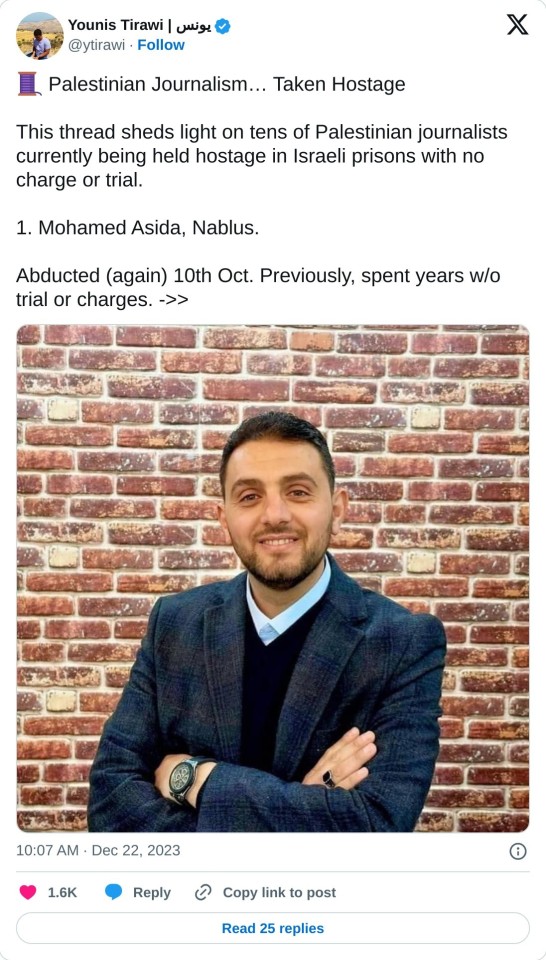
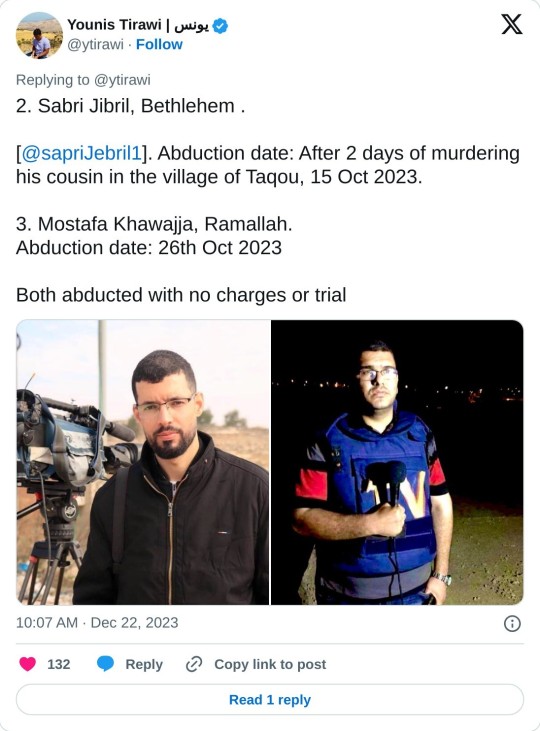

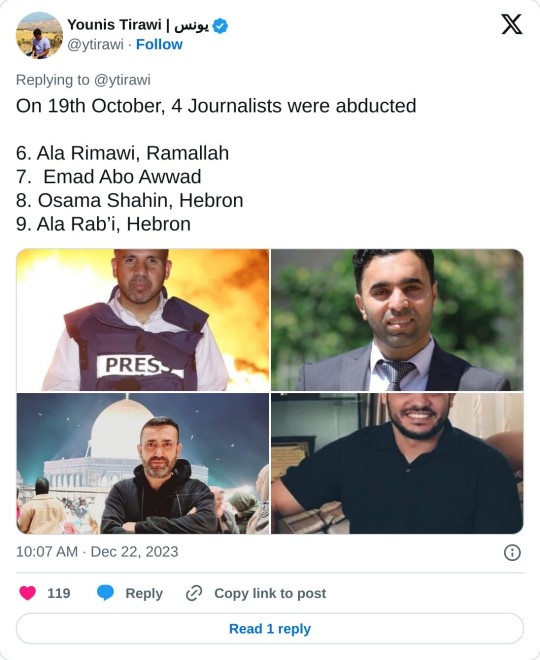
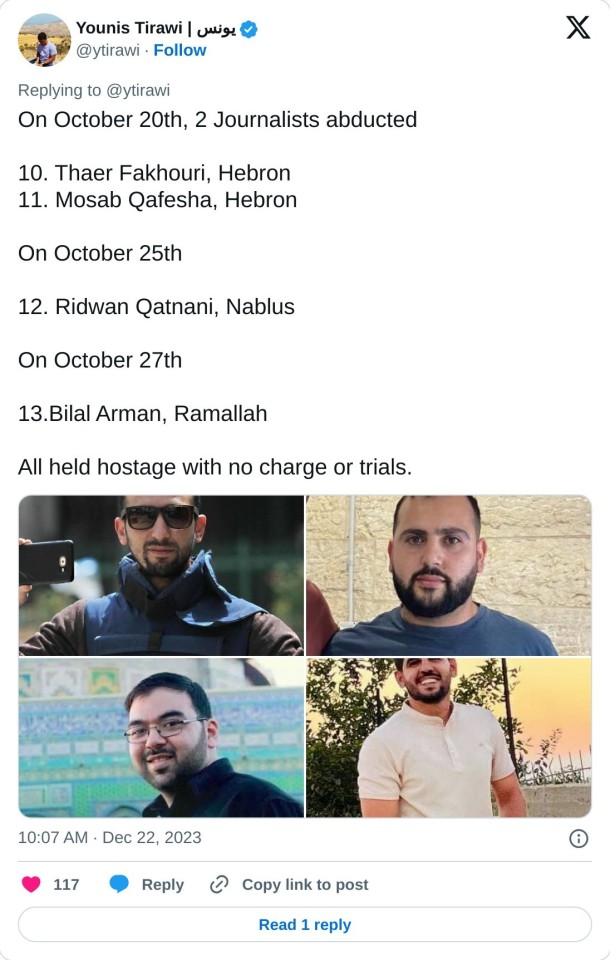
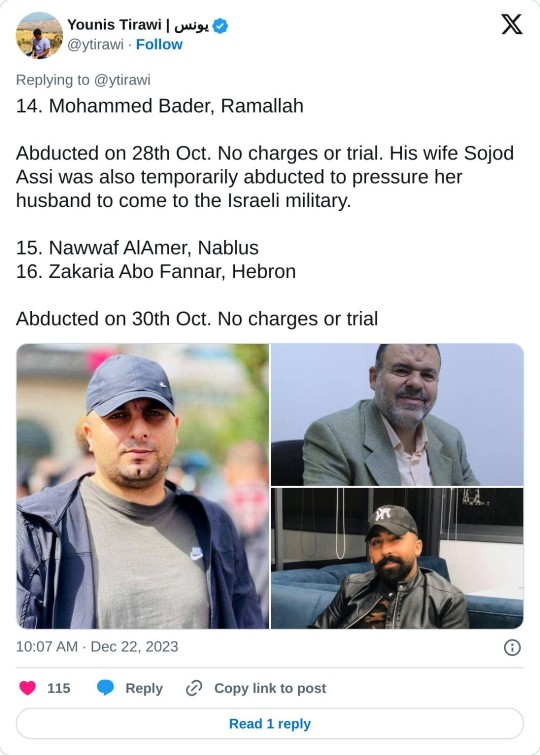

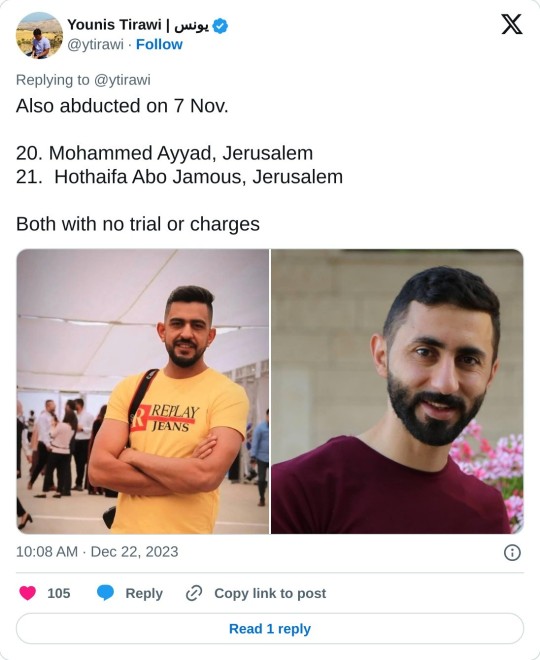

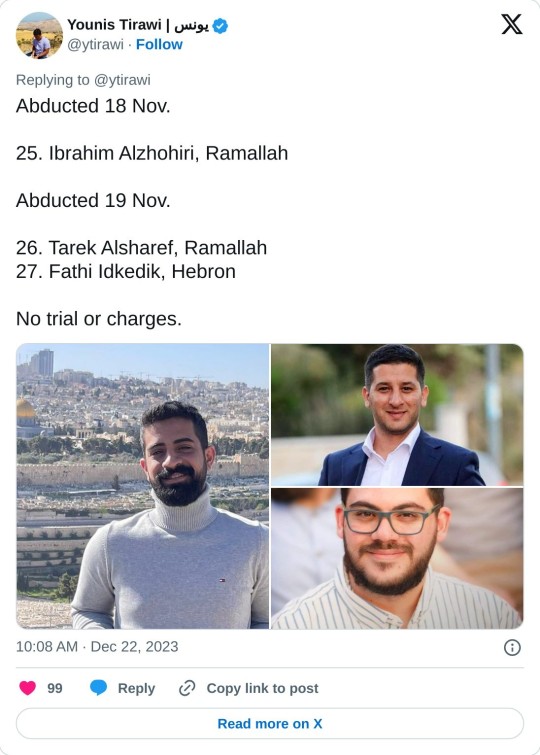


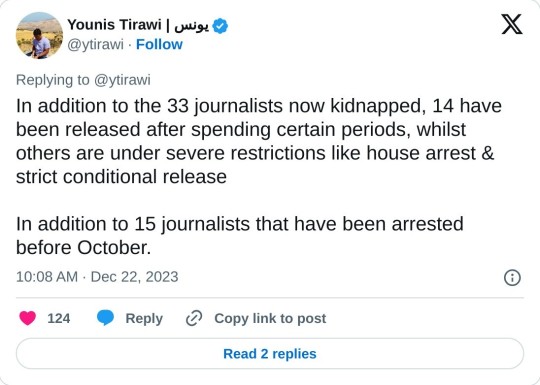
#never forget#another journalist#palestine#free palestine#from the river to the sea palestine will be free#gaza#west bank#bethlehem#jerusalem
61 notes
·
View notes
Text
About the filmmakers:
Director Yassir Murtaja was a Palestinian journalist and filmmaker from Gaza. He was shot and killed by an Israeli sniper while covering the protest of the Great March of Return on April 6, 2018. Many people around the world witnessed Yassir’s wish before he died through his Facebook status: that one day he wanted to be able to see Gaza and the world from the window of an airplane.
Co-Director Rushdi Al-Sarraj was Yassir's best friend and partner. He was killed in Gaza on October 22, 2023, by a targeted bomb from an Israeli warplane, dropped on his house.
83 notes
·
View notes
Text

We are devastated by the news that Roshdi Sarraj was killed in an Israeli airstrike on 22 October that hit his family's home in Tal al-Hawa in Gaza City.
A talented photojournalist, filmmaker, and a co-founder of “Ain Media”, an independent collective of Palestinian photographers and filmmakers based in the Gaza Strip, Roshdi worked with us last year to produce a short film to shed light on the human cost of the August 2022 offensive on the Gaza Strip. We invite you to watch the short film as a tribute to his memory through the link in our bio.
Roshdi is the third member of Ain Media to be killed; Ibrahim Lafi was killed on 7 October, and Yasser Mourtaja was killed while covering the Great March of Return in 2018. Roshdi’s sole purpose was to share stories from Gaza, not just during times of war and sorrow but also the simple and inspiring stories that people in Gaza share on a daily basis between pure joy and utter sadness.
Roshdi is survived by his wife, Shurouq, and his one-year-old daughter, Dania, and by countless friends and colleagues who will continue to be inspired by his example and commitment to truth, justice, and hope.
36 notes
·
View notes
Text
The building was previously targeted by Israeli air strikes on 29 November, with the head of Gaza’s municipality, Yahya al-Sarraj, saying the attack poses “a great danger to the city”, as the building was home to “thousands of historically valuable documents for the community”.
“These documents represent an integral part of our history and culture,” he told Anadolu news agency.
“The Central Archives contain plans for ancient buildings of historical value and documents in the handwriting of well-known national figures,” he added.
23 notes
·
View notes
Text
List of journalists killed in Gaza by IDF
86 journalists, both men and women, have been KILLED BY Israeli army (IDF) since October 7th. The list consists the following names:
1. Journalist Muhammad Al-Salehi
2. Journalist Ibrahim Lafi
3. Journalist Muhammad Jarghoun
4. Journalist Asaad Shamlakh
5. Journalist Saeed Al-Taweel
6. Journalist Hisham Al-Nawajha
7. Journalist Muhammad Abu Rizk
8. Journalist A'id Al-Najjar
9. Journalist Muhammad Abu Matar
10. Journalist Rajab Al-Naqib
11. Journalist Ahmad Shihab
12. Journalist Abdel Rahman Shihab
13. Journalist Hossam Mubarak
14. Journalist Hani Al-Madhoun
15. Journalist Issam Bahar
16. Journalist Muhammad Baalousha
17. Journalist Abdel Hadi Habeib
18. Journalist Ali Nisman
19. Journalist Anas Abu Shamlah
20. Journalist Sameeh Al-Nadi
21. Journalist Khalil Abu Athra
22. Journalist Mahmoud Abu Zareefa
23. Journalist Muhammad Ali
24. Journalist Iman Al-Aqeeli
25. Journalist Muhammad Labad
26. Journalist Muhammad Al-Shurbaji
27. Journalist Rashdi Al-Sarraj
28. Journalist Muhammad Al-Hassani
29. Journalist Sa'id Halabi
30. Journalist Jamal Al-Faqawi
31. Journalist Ahmad Abu Mahadi
32. Journalist Yasser Abu Namus
33. Journalist Salma Makhimer
34. Journalist Duaa Shurafa
35. Journalist Salam Mimeh
36. Journalist Majd Kashkou
37. Journalist Emad Al-Wahidi
38. Journalist Hudhaifa Al-Najjar
39. Journalist Nazmi Al-Nadeem
40. Journalist Majd Arandas
41. Journalist Iyad Matar
42. Journalist Muhammad Al-Biari
43. Journalist Muhammad Abu Hatab
44. Journalist Zaheer Al-Afghani
45. Journalist Mustafa Al-Naqib
46. Journalist Haitham Harara
47. Journalist Muhammad Al-Jaja
48. Journalist Yahya Abu Manea
49. Journalist Muhammad Abu Hseira
50. Journalist Mahmoud Matar
51. Journalist Ahmad Al-Qura
52. Journalist Musa Al-Birsh
53. Journalist Ahmad Feteima
54. Journalist Yaqoub Al-Birsh
55. Journalist Amr Abu Hayeh
56. Journalist Mustafa Al-Sawaf
57. Journalist Abdul Haleem Awad
58. Journalist Sari Mansour
59. Journalist Husayna Islaim
60. Journalist Bilal Jad Allah
61. Journalist Ala'a Al-Namr
62. Journalist Ayaat Khaddoura
63. Journalist Muhammad Al-Zak
64. Journalist Asim Al-Birsh
65. Journalist Muhammad Ayash
66. Journalist Mustafa Bukeir
67. Journalist Amal Zuhd
68. Journalist Musab Ashour
69. Journalist Nader Al-Nazli
70. Journalist Jamal Hinniyah
71. Journalist Abdullah Darwish
72. Journalist Muntasir Al-Sawaf
73. Journalist Marwan Al-Sawaf
74. Journalist Adham Hossuna
75. Journalist Muhammad Faraj Allah
76. Journalist Hudhaifa Lulu
77. Journalist Hassan Faraj Allah
78. Journalist Shaima Al-Jazar
79. Journalist Mahmoud Salem
80. Journalist Abdul Hameed Al-Qarinaawi
81. Journalist Hamada Al-Yazji
82. Journalist Husam Amar
83. Journalist Ola Atallah
84. Journalist Duaa Al-Jabour
85. Journalist Nourmin Qawas
86. Journalist Muhammad Abu Samra

Journalists have been targeted, them and their families.
#gaza#fucking hell#gazaunderattack#free gaza#free palestine#gaza strip#palestine#save gaza#freepalastine🇵🇸#idf
18 notes
·
View notes
Text
"The stories I never wanted to write" by Tareq S. Hajjaj (2 November 2023)



Mahmoud al-Na’ouk, The Dreamer
Rushdie Sarraj, The Journalist
Ismaeel Barda, The Vendor
Remember them. Palestinians are more than just numbers.
Read the full story here:
#image id in alt text#its my first time doing image ID please let me know if there are any errors or how i can make it better and more accessible#palestine#free palestine#gaza#free gaza#west bank#free west bank#journalism#mondoweiss#human rights#humanity#israeli war crimes#genocide#ethnic cleansing#israel occupation#israel#tareq s. hajjaj
26 notes
·
View notes
Text
by Robert Spencer
The New York Times wants you to weep for the people of Gaza, and for what Hamas’ massacre of 1,200 Israelis on Oct. 7, which Gazans cheered in large numbers, has brought upon them. In service of that goal, on Christmas Eve the Paper of Record ran a weepy piece by a prominent Gazan, someone who has witnessed the Israeli incursion firsthand. Did the Times give this plumb editorial space to a “moderate” Gazan, a known foe of the Hamas regime, one of those “innocent Palestinians” who have nothing, nothing whatsoever, to do with Hamas? Uh, not quite.
“I Am Gaza City’s Mayor. Our Lives and Culture Are in Rubble,” was written by Yahya R. Sarraj and published in the Times on Sunday. The Times identifies the author in terms that make him sound like an airy, inoffensive intellectual: “Dr. Sarraj is the mayor of Gaza City and a former rector of the University College of Applied Sciences there. He wrote from Gaza City.”
Yahya R. Sarraj, you see, is no terrorist, he’s a mild-mannered professor. But what the Times doesn’t bother to remind its hapless readers about is the fact that Hamas controls Gaza, and no one can hold the position of being mayor of the largest city in the Gaza Strip without being either an active Hamas member or entirely sympathetic with the terror group’s outlook and goals. Sarraj even alludes to this matter-of-factly in his piece, writing: “One of my major goals after the Hamas administration appointed me mayor in 2019 was to improve the city’s seafront and foster the opening of small businesses along it to create jobs.”
Sarraj spends the bulk of his article doing his best to move the reader to rage against Israel. “As a teenager in the 1980s,” he says, “I watched the construction of the intricately designed Rashad al-Shawa Cultural Center in Gaza City, named after one of Gaza’s greatest public figures, and its theater, grand hall, public library, printing press and cultural salon.”
This place was so impressive that Sarraj says even Bill Clinton visited it while he was president; it was, in fact, “the gem of Gaza City,” and it meant a great deal to Sarraj personally: “Watching it being built inspired me to become an engineer, which led to a career as a professor and, in the footsteps of al-Shawa, as mayor of Gaza City. Now that gem is rubble. It was destroyed by Israeli bombardment.”
Sarraj claims that “Israel, which began its blockade of Gaza more than 16 years ago and has maintained what the United Nations and human rights groups call an ongoing occupation for far longer, is destroying life here.” Destroying life! Sixteen years ago, in 2007, the population of Gaza was 1,416,543, up from 1,022,207 in 1997. In 2023, it’s 2.2 million, 64% higher than it was in 2007. If the Israelis are “destroying life” in Gaza and even committing a genocide, as many have charged, they’re doing a remarkably ineffective job of it.
Sarraj laments: “Why can’t Palestinians be treated equally, like Israelis and all other peoples in the world? Why can’t we live in peace and have open borders and free trade?” He doesn’t offer any answers, so I will, as the answer is not elusive at all: if Palestinians would stop trying to murder Israeli civilians and destroy the state of Israel altogether, they could have all of that and more.
Why is the New York Times publishing Hamas propaganda? Because doing so is consistent with its longstanding editorial policies. Ninety years ago, on July 9, 1933, just over five months after Adolf Hitler became chancellor of Germany and years after his virulent anti-Semitism and propensity for violence had become internationally known, the Times published a fawning puff piece on the Führer.
Pulitzer Prize-winning “journalist” Anne O’Hare McCormick traveled to Berlin to interview the new chancellor, and in his presence, she was starstruck: “At first sight,” McCormick gushed, “the dictator of Germany seems a rather shy and simple man, younger than one expects, more robust, taller. His sun-browned face is full and is the mobile face of an orator.” McCormick seemed to have a crush on the future butcher of Europe: “His eyes are almost the color the blue larkspur in a vase behind him, curiously childlike and candid. He appears untired and unworried. His voice is as quiet as his black tie and his double-breasted black suit.”
Hitler, McCormick signaled to her readers, was reasonable and genuine: “He begins to speak slowly and solemnly but when he smiles — and he smiled frequently in the course of the interview — and especially when he loses himself and forgets his listener in a flood of speech, it is easy to see how he sways multitudes. Then he talks like a man possessed, indubitably sincere.” What’s more, “Herr Hitler has the sensitive hand of the artist.”
In the 29th paragraph of a 41-paragraph article, McCormick says that she asked him: “How about the Jews? At this stage how do you measure the gains and losses of your anti-Semetic [sic] policies?” Hitler answered, she said, with “extraordinary fluency,” and she records his answer – a tissue of victim-blaming and excuse-making – at considerable length. Later, she says, “Herr Hitler’s tension relaxed. He smiled his disarming smile.”
Little did Anne O’Hare McCormick realize, as Hitler’s blue larkspur eyes twinkled in her direction and his disarming smile made her heart flutter, that all these years later, the New York Times would not only be publishing puff pieces about authoritarian thugs, but giving them space to propagandize to their heart’s content.
#yahya r sarraj#adolph hitler#new york times#anne o'hare mccormick#gaza city#mayor of gaza city#hamas#gaza#media bias
15 notes
·
View notes
Text
Gaza’s Central Archives building lies in ruins after Israeli air strike
youtube
“This destruction was particularly hard for us because it holds the memory of Gaza City.”
Gaza’s local authorities have confirmed the destruction of the Central Archives building that was targeted by Israeli airstrikes prior to the ceasefire agreement between Israel and Hamas.
According to Yahya Al-Sarraj, Mayor of Gaza City, the attacks caused “the burning of historically significant documents dating back over 150 years.”
Israel is in the process of annihilating the Palestinians not only as a people in the present but as a people who ever even existed
6 notes
·
View notes
Text
…. Dans un communiqué publié vendredi, Reporters sans frontières (RSF) dénonce une volonté de black-out de la part d’Israël sur l’information en provenance de Gaza. Journalistes tués ou blessés, rédactions détruites, coupures d’Internet et menace de censure de la chaîne internationale Al Jazeera : Israël étouffe progressivement depuis près de deux semaines l’information dans la bande de Gaza….
3 notes
·
View notes
Text



(Source: Al-Jazeera, WHO)
In addition, 19 journalists have been killed, including what appear to be targeted attacks: the latest victim is photo journalist Rushdi Sarraj, killed in his home in a targeted bombing.
Additionally, Israel has launched attacks targeting Syrian airports, residents of the West Bank, and areas of Lebanon.
Israel is using genocidal language and actively committing genocide and war crimes, with the UN useless to do anything thanks to the US’ vetoing any accountability as they have a permanent security council seat.
This is not a “defense” to Hamas’ attack.
They are using this as an opportunity to eliminate Palestinians once and for all - something Netanyahu and his cabinet is making clear in their language and actions. Netanyahu wants this as his legacy.
While I continue to support donations to legitimate Palestinian aid organizations (I will reblog my post to encourage such), this will not end until Israel is held accountable. And that won’t end until the US stops its hypocritical support globally of regimes like Israel that commit human rights violations daily, because it benefits the US’ perverse agenda of international order and exploitation.
Write to your representatives in government — tell them you do not support Israel’s genocide. They must know that their constituents do not support the wall of continued blind US-Israeli defense.
2 notes
·
View notes
Text

🔹🔷Yunus ibn Zabyan, al-Mufaddal ibn Umar, Abu Salama al-Sarraj and Hussein ibn Thuwayr ibn Abi Fakhitah said:"We were in the presence of Abu Abdillah, peace be upon him, when he said: We've the treasures of the earth and its keys. If I wished to say with one of my foot (by striking it on the ground): 'Let out whatever gold is in you', it would do so.He (the narrator) said: "Then he said so with (striking) one of his feet and drew a line with it on the earth. The earth split open. Then he pulled out a brick of gold, the size of a hand and said: 'Look closely'. We looked (down) and saw many such blocks of gold, shining, one over the other. One of us said to him: 'May I be made your ransom! You've been given such whilst your Shi'a are in need?' The Imam said: 'Allah will combine
for us and our Shi'a (the bounties of both) the world and the hereafter. And He will admit them into the blessings of Paradise whilst our enemies will enter Hell-fire'".
📚Mustadrak al-Wasael, vol.9, p.353.
4 notes
·
View notes